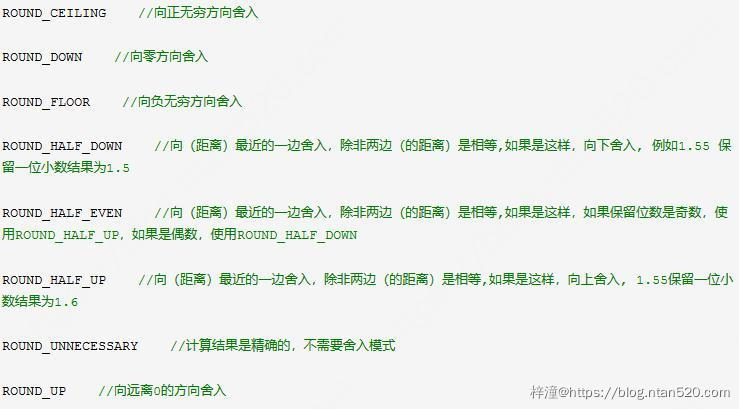文章内容
Java在java.math包中提供的API类BigDecimal,用来对超过16位有效位的数进行精确的运算。双精度浮点型变量double可以处理16位有效数。在实际应用中,需要对更大或者更小的数进行运算和处理。float和double只能用来做科学计算或者是工程计算,在商业计算中要用java.math.BigDecimal。BigDecimal所创建的是对象,我们不能使用传统的+、-、*、/等算术运算符直接对其对象进行数学运算,而必须调用其相对应的方法。方法中的参数也必须是BigDecimal的对象。构造器是类的特殊方法,专门用来创建对象,特别是带有参数的对象。
BigInteger 也可以存放比较大的数, 和 BigDecimal 的区别是 :BigInteger 存放的是大的整数,而BigDecimal 存放大的小数。
1、BigDecimal构造方法
BigDecimal一共有4个构造方法:
- BigDecimal(int) 创建一个具有参数所指定整数值的对象。
- BigDecimal(double) 创建一个具有参数所指定双精度值的对象。(不建议采用)
- BigDecimal(long) 创建一个具有参数所指定长整数值的对象。
- BigDecimal(String) 创建一个具有参数所指定以字符串表示的数值的对象。
实例化方法:
- BigDecimal BigDecimal(double d); //不允许使用
- BigDecimal BigDecimal(String s); //常用,推荐使用
- static BigDecimal valueOf(double d); //常用,推荐使用
注意:
- double 参数的构造方法,不允许使用,因为它不能精确的得到相应的值,值会变大;
- String 构造方法是完全可预知的: 写入 new BigDecimal(“0.1”) 将创建一个 BigDecimal,它正好等于预期的0.1; 因此,通常建议优先使用 String 构造方法;
- 静态方法 valueOf(double val) 内部实现,仍是将 double 类型转为 String 类型; 这通常是将 double(或float)转化为 BigDecimal 的首选方法。
BigDecimal 类的 valueOf()方法源码:
public static BigDecimal valueOf(double val) {
return new BigDecimal(Double.toString(val));
}
2、BigDecimal格式化
由于NumberFormat类的format()方法可以使用BigDecimal对象作为其参数,可以利用BigDecimal对超出16位有效数字的货币值,百分值,以及一般数值进行格式化控制。 以利用BigDecimal对货币和百分比格式化为例。首先,创建BigDecimal对象,进行BigDecimal的算术运算后,分别建立对货币和百分比格式化的引用,最后利用BigDecimal对象作为format()方法的参数,输出其格式化的货币值和百分比 。
BigDecimal bigLoanAmount = new BigDecimal("具体数值"); //创建BigDecimal对象
BigDecimal
bigInterestRate = new BigDecimal("具体数值");
BigDecimal bigInterest = bigLoanAmount.multiply(bigInterestRate);//BigDecimal运算
NumberFormat
currency = NumberFormat.getCurrencyInstance(); //建立货币格式化引用
NumberFormat percent = NumberFormat.getPercentInstance(); //建立百分比格式化用
percent.setMaximumFractionDigits(3); //百分比小数点最多3位
//利用BigDecimal对象作为参数在format()中调用货币和百分比格式化
System.out.println("Loan amount:t" + currency.format(bigLoanAmount));
System.out.println("Interest rate:t" + percent.format(bigInterestRate));
System.out.println("Interest:t" + currency.format(bigInterest));
输出结果:
Loan amount: ¥129,876,534,219,876,523.12
Interest rate: 8.765%
Interest:
¥11,384,239,549,149,661.69
常见用法:
初始化 BigDecimal a= new BigDecimal("1.35");
对数值取值:
1.a.setScale(1,BigDecimal.ROUND_DOWN);
取一位小数,直接删除后面多余位数,故取值1.3.
2.a.setScale(1,BigDecimal.ROUND_UP);
取一位小数,删除后面位数,进一位,故取值1.4.
3.a.setScale(1,BigDecimal.ROUND_HALF_UP);
取一位小数,四舍五入,故取值1.4.
4.a.setScale(1,BigDecimal.ROUND_HALF_DOWN);
取一位小数,五舍六入,故取值1.3.
3、BigDecimal加减乘除运算
对于常用的加,减,乘,除,BigDecimal类提供了相应的成员方法 :
- public BigDecimal add(BigDecimal value); //加法
- public BigDecimal subtract(BigDecimal value); //减法
- public BigDecimal multiply(BigDecimal value); //乘法
- public BigDecimal divide(BigDecimal value); //除法
用法如下:
BigDecimal bignum1 = new BigDecimal("10");
BigDecimal bignum2 = new BigDecimal("5");
BigDecimal bignum3 = null;
//加法
bignum3 = bignum1.add(bignum2);
System.out.println("和 是:" + bignum3);
//减法
bignum3 = bignum1.subtract(bignum2);
System.out.println("差 是:" + bignum3);
//乘法
bignum3 = bignum1.multiply(bignum2);
System.out.println("积 是:" + bignum3);
//除法
bignum3 = bignum1.divide(bignum2);
System.out.println("商 是:" + bignum3);
注意:
BigDecimal除法可能出现不能整除的情况,比如 4.5/1.3,这时会报错java.lang.ArithmeticException: Non-terminating decimal expansion; no exact representable decimal result。
divide方法有可以传三个参数:public BigDecimal divide(BigDecimal divisor, int scale, int roundingMode) 第一参数表示除数, 第二个参数表示小数点后保留位数,第三个参数表示舍入模式,只有在作除法运算或四舍五入时才用到舍入模式,有下面这几种:

ROUND_CEILING
Rounding mode to round towards positive infinity.
向正无穷方向舍入
ROUND_DOWN
Rounding mode to round towards zero.
向零方向舍入
ROUND_FLOOR
Rounding mode to round towards negative infinity.
向负无穷方向舍入
ROUND_HALF_DOWN
Rounding mode to round towards "nearest neighbor" unless both neighbors are equidistant, in which case round down.
向(距离)最近的一边舍入,除非两边(的距离)是相等,如果是这样,向下舍入, 例如1.55 保留一位小数结果为1.5
ROUND_HALF_EVEN
Rounding mode to round towards the "nearest neighbor" unless both neighbors are equidistant, in which case, round towards the even neighbor.
向(距离)最近的一边舍入,除非两边(的距离)是相等,如果是这样,如果保留位数是奇数,使用ROUND_HALF_UP ,如果是偶数,使用ROUND_HALF_DOWN
ROUND_HALF_UP
Rounding mode to round towards "nearest neighbor" unless both neighbors are equidistant, in which case round up.
向(距离)最近的一边舍入,除非两边(的距离)是相等,如果是这样,向上舍入, 1.55保留一位小数结果为1.6
ROUND_UNNECESSARY
Rounding mode to assert that the requested operation has an exact result, hence no rounding is necessary.
计算结果是精确的,不需要舍入模式
ROUND_UP
Rounding mode to round away from zero.
向远离0的方向舍入
4、BigDecimal 比较大小
BigDecimal使用compareTo方法比较大小:
BigDecimal num1 = new BigDecimal("0");
BigDecimal num2 = new BigDecimal("1");
BigDecimal num3 = new BigDecimal("2");
BigDecimal num = new BigDecimal("1"); //用做比较的值
System.out.println(num1.compareTo(num));//小于 时,返回 -1
System.out.println(num2.compareTo(num));//等于 时,返回 0
System.out.println(num3.compareTo(num));//大于 时,返回 1
5、其他常用方法
/**
* 求余数
* 返回值为 (this % divisor) 的 BigDecimal
*/BigDecimal remainder(BigDecimal divisor);
/**
* 求相反数
* 返回值是 (-this) 的 BigDecimal
*/BigDecimal negate();
/**
* 将此 BigDecimal 与指定的 BigDecimal 比较
* 根据此方法,值相等但具有不同标度的两个 BigDecimal 对象(如,2.0 和 2.00)被认为是相等的;
* 相对六个 boolean 比较运算符 (<, ==, >, >=, !=, <=) 中每一个运算符的各个方法,优先提供此方法;
* 建议使用以下语句执行上述比较:(x.compareTo(y) <op> 0), 其中 <op> 是六个比较运算符之一;
*
* 指定者:接口 Comparable<BigDecimal> 中的 compareTo
* 返回:当此 BigDecimal 在数字上小于、等于或大于 val 时,返回 -1、0 或 1
*/int compareTo(BigDecimal val);
